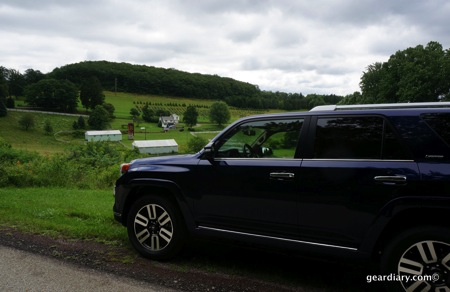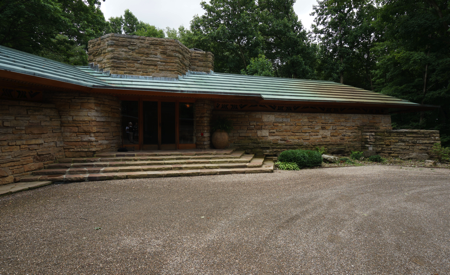
As I mentioned in a brief post the other day, last week I had the opportunity to travel to south-western Pennsylvania to stay at the Nemocolin Woodlands Resort and see, and drive, the 2014 Toyota Tundra and 2014 Toyota 4Runner. The resort was amazing and served as a terrific backdrop for getting to know the new Tundra and 4Runner. What follows is a brief description of our day along with some details on two lines of trucks that — spoiler alert — impressed the heck out of me.
A bit of background.
On farms throughout America, pickup trucks are like a member of the family. Mike Sweers is living the dream of every kid who was raised in farm country: He gets paid to create trucks. Sweers, who still runs an active hay farm in Northern Michigan, has used his mechanical engineering degree, and life experiences as a farmer, to aid him as the chief engineer of Toyota pickup trucks; especially the development of the new 2014 Tundra full-size pickup. Toyota PR
Unlike Judie (who runs her family’s ranch) or Travis (who lives in rural Texas), both of whom drive trucks out of necessity, I live in suburban New Jersey and am quite content with my small sedan. In fact, the number of times that I have actually driven a truck can be counted on one or two hands. So having the opportunity to not only drive Toyota’s newest trucks on the highway but to take both of them off-road promised to be an experience – one that allowed someone with new eyes to become familiar with the vehicles in a way a truck-driving aficionados might not. It also meant I approached the initial period of driving both vehicles with a bit of caution. After all, the last thing I wanted to do was to wreck one of the very first 2014 Tundras or 4Runners. 🙂 I share this because my hesitation about driving both vehicles becomes important when I actually describe getting behind the wheel.

The first vehicle that we drove was the 2014 Toyota 4Runner. The 4Runner:
combines rugged body on frame construction with comprehensive suspension technology that yields optimal off-road capability with a smooth riding comfort more often associated with crossovers.
As you will see, that was certainly my experience. The vehicle comes in three grades: the well-equipped, value driven SR5, the top-of-the-line Limited, and a Trail grade for those who want “maximum off-road capability”. If you are looking for the ability to have seven people in your vehicle both the SR5 and the Limited have an optional third row seat. Those purchasing the 4Runner have the choice of a rear wheel 4 x 2, a part-time 4 x 4 or a full-time multimode 4 x 4 with locking center differential. All models are equipped with a powerful 4.0 L 270 hp V-6 engine.
Where the 4Runner really impressed me was in its ability to be both a comfortable driving vehicle on the road and a capable off-road machine. As Toyota explains,
A double-wishbone independent front suspension, combined with a variable flow rack and steering, help give the forerunner precise control and demanding roads. Coil springs over gas shocks are used on all four wheels for a comfortable ride and controlled handling. The four-link rear suspension maximizes off-road axle articulation, while providing a smooth ride for rear seat passengers on and off pavement.
You can read all the technical specifics here on Toyota’s website. Let’s jump into the experience of actually driving the 4Runner.

Paul Strauss from The Awesomer and Technabob took the wheel for the first leg, while I was shotgun and navigator. I was immediately impressed with the vehicle. I did not expect the 4Runner to be as luxurious or comfortable and refined as it was. And it was quiet. And it was fast… I discovered just HOW fast it was after we had pulled over for this shot…

You see while we were taking some scenic pictures one of the other vehicles passed us by. Paul, who drives an American muscle car, would have none of that. He “demonstrated” the excellent acceleration of the vehicle. Yes, it is fast and handles exceptionally well.

The drive led us to Kentuck Knob, a Frank Lloyd Wright home that was built on 80 acres in the mountains above Uniontown, in Western Pennsylvania. At just 2200 sq ft (Wright originally designed it to be just 1200 sq ft, but the owner Bernardine Hagan was tenacious and pushed the architect to make specific areas larger) it is small, but does not feel that way. I had never been in a Frank Lloyd Wright home, and I was impressed with the use of space, the openness create by the walls of windows.
- The house
- The house
- Interior detail
- The view with the house behind
- The view
The details throughout the house are beyond impressive. The answer to the question “Could you see yourself living here?” was, “Hell yeah!”
For the return trip, we jumped into the new 2014 Toyota Tundra. Development of the 2014 model began in the summer of 2010. The goal was to create a new, chiseled appearance that gave a bold appearance on the front end and immediately announced the tundra’s capability as a full-size pickup. At the same time, Toyota wanted to give the truck a new, more refined interior. They also wanted to create a more ergonomic experience. This resulted in the center stack being moved 2.6 inches closer to the driver and putting all of the controls within easier reach. As Toyota explains, “refinement was a top priority as all Tundra grades are designed with newly structured seats and premium leathers and fabrics for more comfort and eye appeal.” To my eye and my experience they succeeded on all counts.
They also added important new technologies to the truck. They updated the Entune audio system and gave it a larger touchscreen. They made the backup camera standard, and this is the first full-size truck with a Blind Spot Monitor with Rear Cross Traffic Alert. As a gadget lover, I was impressed with the fact that you can drive a full-size pickup while not giving up any of the technological bells and whistles that have become standard on smaller vehicles.
This is a big truck that is designed for people who need a serious work truck but also want an enjoyable ride. At first I was worried that I, the owner of a Lexus IS250 AW, would have an issue driving the Tundra. That simply wasn’t the case. While large, the Tundra handles incredibly well. In addition, acceleration and braking were impressive.

And while we weren’t hauling anything, I could immediately understand why the 2014 Tundra can handle up to 10,000 pounds in tow.
Now it was time to see what the 2014 Toyota 4Runner and Tundra could do off-road. The Tundra was first. Big, powerful and yet incredibly comfortable, the truck did quite well cutting through the water, driving over logs and dealing with steep muddy hills. The length of the truck however made it a bit of a challenge on some of the narrow parts of the wooded course. It got through just fine, but it took a bit of additional navigation. (Disclaimer: I wasn’t brave enough to try the wooded portion of the course and remained a passenger while those who are more familiar with driving trucks off the road took the wheel.) Here are a few pictures and a taste of what it was like to be in the driver seat for the mellower portion of the course.
Then it was time to try our hand at the 4Runner off-road. I posted on this last week, but didn’t discuss the actual experience of driving the vehicle. In all, it was incredibly impressive and, after driving the Tundra the 4Runner – not a small vehicle at all – felt like a compact with regard to both comfort and handling.

It was immediately clear that this is a vehicle designed for off-road while the Tundra is a work vehicle – it went through the water with aplomb. It raced over felled logs with no issue, and it made it up the hill without a problem. I did drive the 4Runner in the wooded portion of the course, and I found that it handled everything quite beautifully. But as Paul was quick to point out, it wasn’t my driving that make the difference but rather the vehicles technology. Honestly, what I quickly discovered was that if I set the truck in the right direction and let it do the work, it was able to overcome most obstacles on its own. Yes, it’s that capable. Here’s the video we shared last week.
And here are a few more pictures.
The bottom line for me was this. If you need to haul a significant amount the 2014 Tundra is an impressive and comfortable way to get your work done. If, like me, you rarely, if ever, need to have something in tow — but you want the comfort, capacity and off-road ability of a sport-utility vehicle — then the 2014 4Runner is a great option. Better still, if you need it to it can, and will, tow equipment. It was easy to drive, incredibly comfortable and when you move to the fancier trim, quite luxurious. Even I, as a Lexus owner, would be beyond happy to be driving one of these vehicles.

For more information on both vehicles check out the Toyota website.







